#Mountebank Arcana
Text
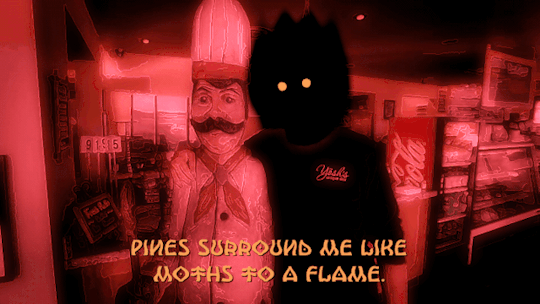


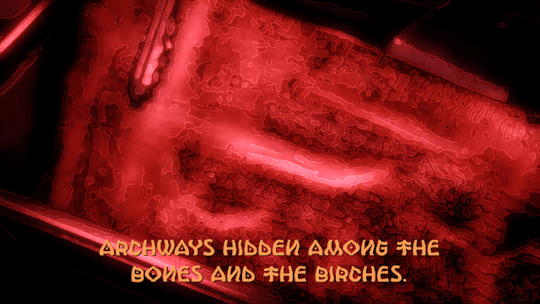


[Pines surround me like moths to a flame. And the wind whispers the Other's name. Requiem roads and infinite searches. Archways hidden among the bones and the birches. Mountebanks of the hinterlands. Subservient only to the water's plans.]
#s33e09 unique eats#guy fieri#guyfieri#diners drive-ins and dives#i tego arcana dei#infinite searches#pines#moths#flame#wind#other#name#roads#archways#bones#birches#mountebanks#hinterlands#water#plans
177 notes
·
View notes
Text
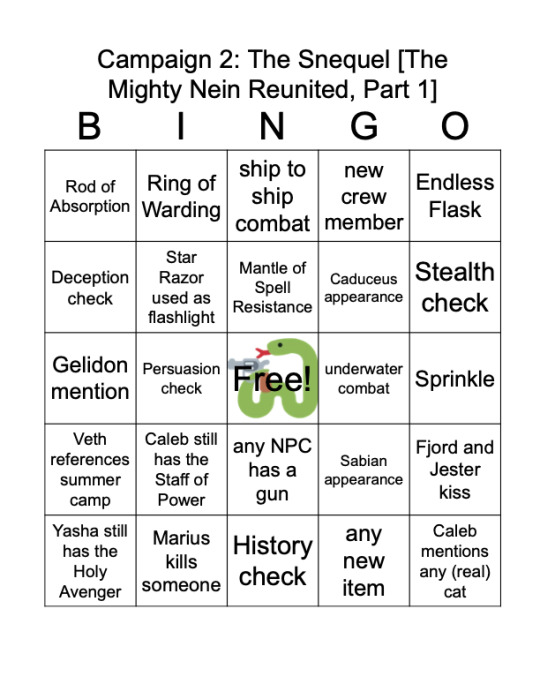

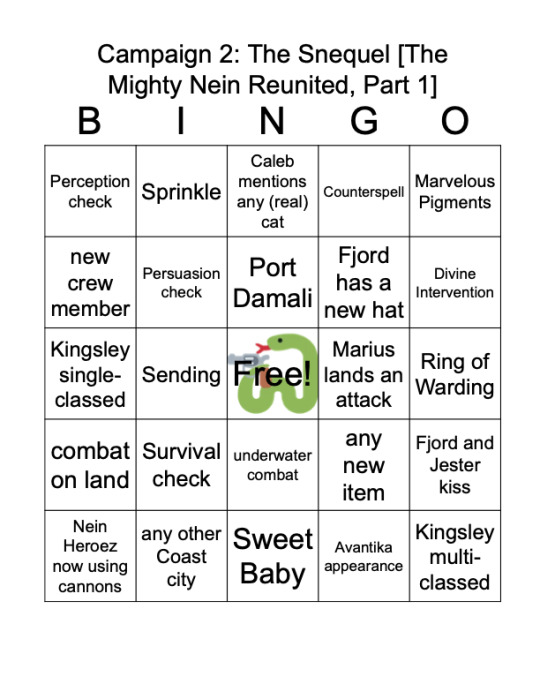
The babes are back in town! I'm VERY excited, you can tell because I got bingo done a little early for once, and I'm sure everyone else is too. I've put together a bingo call list for the Nein reunited. Just like the C2 finale's call list, this is 69 items. You can find them all below the cut, and you can get your own bingo card here at BingoBaker. Here's some notes for the call list.
"Fjord has a new hat" is rather generous. Since it is pretty impossible to tell if it's the SAME hat as the one he had in Eiselcross, I'm going to say that if he is described with ANY hat, this square is legal.
"Fjord has a tattoo" does not require it be magical. A non-magical tattoo counts, but a magical one is fun.
"any (real) cat" generally is for any cat that isn't Frumpkin. Ergo, mentioning Frumpkin as a cat who once accompanied Caleb does not count. (He was a fey cat, rather than a beast cat, anyway.) The Tower counts also do NOT count, by virtue of not being real cats.
Any item listed by name, the item must be used for it to count as a square. For example, Beau teleporting using the Cape of the Mountebank make the square legal. Endless Flask counts if it's offered or drunk from.
"Sweet Baby" is Veth's gun. If Veth has acquired more bullets and shoots her gun, that's the square for it.
"any new item" is for any item that the Nein did NOT have at the end of the campaign. This is any item they may have acquired between now and the end of the campaign OR any item they newly acquire during this episode.
"new crew member" is for any new NAMED crew member of the Nein Heroez. The currently known crew is: Fjord, Orly, Marius, Gallan, Shelda, Kingsley, and Jester. Should he have decided to join the crew since, Vandran also counts as existing crew.
"ship to ship combat" is basically any combat between ships as entities in themselves, i.e. cannon fire. "Combat on deck" is largely between PCs individually. A single combat CAN be both.
If it is mentioned that Marius has killed someone BEFORE this episode, it DOES count for "Marius kills someone"
Any listed spell does count if an NPC casts it.
"Veth casts a new spell" covers cantrips as well.
Fjord was mentioned as having Cone of Cold during the campaign, but casting is now DOES count for "Fjord or Caleb casts new spell" bc it was never cast. Friends counts for the same reason.
As always, you can ask me for clarifications before, during, or after the episode into the rest of the week! I always love seeing your bingos or almost bingos—and I also love seeing some fun rows you hope will happen ahead of the episode.
May the Nein bring you luck this week.
Fjord has a new hat
Fjord has a tattoo
Star Razor used as flashlight
Caleb still has the Staff of Power
Caleb mentions any (real) cat
Veth references summer camp
summer camp kid named
Kingsley multi-classed
Kingsley single-classed
Yasha still has the Holy Avenger
Sprinkle
Cape of the Mountebank
Endless Flask
Marvelous Pigments
Inescapable Lash (my beloved)
Sweet Baby
Mantle of Spell Resistance
Ring of Telepathy
Ring of Warding
Rod of Absorption
Winged Boots
any new item
new crew member
ship to ship combat
combat on deck
underwater combat
combat on land
Nein Heroez still using ballistae
Nein Heroez now using cannons
Marius kills someone
Marius hasn't killed anyone
Marius lands an attack
Orly casts a spell
any NPC has a gun
any PC uses explosives
Beau and Yasha kiss
Fjord and Jester kiss
Darktow
Nicodranas
Port Damali
any other Coast city
Avantika appearance
Caduceus appearance
Sabian appearance
Vandran appearance
Kotho mention or appearance
Gelidon mention
Divine Intervention
Marine Layer
Fury of the Tides
Stunning Strike
Cone of Cold
Counterspell
Polymorph
See Invisibility
Sending
Voltaic Bolt
illusion cast
Veth casts a new spell
Fjord or Caleb casts a new spell
Arcana check
Deception check
History check
Insight check
Intimidation check
Perception check
Persuasion check
Stealth check
Survival check
176 notes
·
View notes
Text
Sometimes, such as now approaching 1:30AM on this Tuesday morning, there is nothing more that my brain would like to do than make long lists of things and then chart out how they vaguely correlate in an indescribable but essential-feeling way to long lists of other things. And perhaps do so in a shaky hand-written cypher that I will claim to have been taught by a devil that wore the shape of a raven with the head of a human infant. Or perhaps in a google spreadsheet that will get crawled by AI and wind up fucking up the data set so that when someone later asks chatgpt to write their chemistry paper it will offer up a whole paragraph about how the element of bismuth correlates to the Major Arcana of the Magician.
This is why I'm glad modern cults rely so much on charismatic leadership and peer pressure, factors against which I am largely insulated by irregular neurochemistry. Because if any of these slick mountebanks could be assed to compile a proper occult framework like in the good ol' days, my psyche would clearly stick to it like flypaper.
#in retrospect I doubt I would have stuck with mormonism as long as I did if the temple ceremony weren't a straight-up magic ritual#and the formulaic nature of priesthood rites fit what I wanted a religion to be as a huge-ass D&D playing dork#at least until I started thinking seriously about the impact for good or evil of the church's dogshit politics#and then it all lost its allure very quickly
0 notes
Note
Hey Skull, is Xuppu advocating for some April Fools shenanigans?
Ryuji: He knows better than ta do something without letting me know. I got the Guardian on speed-dial, just in case.
Ryuji: Luckily fer me, he only wants to do kindly pranks.
His phone rings with an incoming call from Juleka.
Juleka: Why is Marinette freaking out about nacho cheese covering Jagged Stone's room?
Ryuji: ... Xuppu!
Xuppu: Wasn't me, boss!
Ryuji: Uh-huh. How do you prove that?
Xuppu: How would I get to Paris to do that and back in time?
Juleka: ... well, he's not wrong there. But who could do such a thing...?
In Nino's room, Kaalki smirks to herself before licking up a teeny bit of queso off of her face.
Kaalki: Oh, darling, you've truly outdone yourself.
A shadow looms over her. She looks up to see a stern-looking Nino.
Nino: So what’s this I heard about a whole pig farm going into space?
Kaalki, gulping: Er... April Fools?

#RYVAL#Miraculous Ladybug#Persona 5#Persona#Ryuji Sakamoto#Xuppu#Saruchame#Captain Arcana#Juleka Couffaine#Sorcerer Arcana#Nino Lahiffe#Kaalki#Shadow Barb#Artisan Arcana#Marinette Dupain-Cheng#Luck Arcana#Jagged Stone#Mountebank Arcana
7 notes
·
View notes
Text
Gnostic Boardwalk

Canonical stature is a fragile and contingent thing, which is why powerful institutions seek to shore up the various canons of art with rankings and plaudits. We’ll play along by asserting that one of our favorite “B” movies was originally screened by Henri Langlois at the Cinematheque française with Georges Franju in attendance. Night Tide (1961) was an unlikely contender for this particular honor—shot guerrilla style on an estimated $35,000 budget, and intended, by its distributors at least, for a wider, less demanding audience seeking mostly air-conditioned escapism.
With its hinky cast—nonfictional witch, Marjorie Cameron; erstwhile muse to surrealist filmmaker Jean Cocteau, the undersung Babette who usually appears en travesti; and lecherous, booze-addled, fresh-faced Hollywood castoff Dennis Hopper—Night Tide invades the drive-in. A tarot reading at the film’s heart gives Marjorie Eaton her time to shine, traipsing into nickel-and-dime divination from her former life as a painter of Navajo religious ceremonies. Linda Lawson might have issued from an etching by Odilon Redon, with her raven locks and spiritual eyes, our resident sideshow mermaid. Not surprisingly and despite such gentle segues, the film itself traveled a rocky road from festivals to paying venues.
Night Tide had spent three years languishing in the can when distributor Roger Corman smuggled the unlikely masterwork into public consciousness, another of his now legendary mitzvahs to art. And the sleazy-sounding double bills that resulted also unleashed an aberrant wonder: the movie’s compact leading man, a force previously held captive by the studio system—looking, here, like some homunculus refugee from the Fifties USA. Dennis Hopper, in his first starring role, would later recall that it represented his first “aesthetic impact” on film since his earlier appearances in more mainstream productions such as Rebel Without a Cause and Giant had denied him meaningful outlets for collaboration.

It’s the presence of its featured players—certainly not their star power—that lends the film its haunting and enduring legacy, and elevates the term “cult classic” to its rightful place in the pantheon of cinema. But we argue that Night Tide remains outside these exclusive parameters—upholding an elsewhere-ness that defies commercial, if not strictly canonical, logic. Curtis Harrington’s first feature film escapes taxonomy, typology or genre—gets away—fueling itself on acts of solidarity instead. If Hopper contributes his dreamy aura, then Corman rescues the seemingly doomed project by re-negotiating the terms of a defaulted loan to the film lab company that was preventing the film’s initial release. His generous risk birthed a movie monument that would add Harrington’s name to a growing collection of talent midwifed by the visionary schlockmeister responsible for nursing the auteurs of post-war American cinema. And here we enter a production history as gossamery as Night Tide itself.
Unlike his counterparts entrenched within the studio system, Harrington was an artist – i.e. a Hollywood anachronism, with aristocratic graces and a viewfinder trained on the unseen. We see Harrington as Georges Méliès reborn with a queer eye, casting precisely the same showman’s metaphysics that spawned cinema onto nature. By the time moving pictures were invented, artists were moving away from a bloodless representational ethos and excavating more primordial sources for inspiration. The early stirrings of what surrealist impresario André Breton would later proclaim: “Beauty will be CONVULSIVE or it will not be at all.”
Harrington owned a pair of Judy Garland’s emerald slippers, and according to horror queen/cult icon Barbara Steele, also amassed an eclectic array of human specimens: “Marlene Dietrich, Gore Vidal, Russian alchemists, holistic healers from Normandy, witches from Wales, mimes from Paris, directors from everywhere, writers from everywhere and beautiful men from everywhere.” On a hastily constructed Malibu boardwalk, Hopper would be in his milieu among the eccentric denizens of California’s artistic underground—most notably, Harrington himself, a feral Victorian mountebank of a director who slept among mummified bats, practiced Satanic rites, and hosted elaborate and squalid dinner parties. One could almost picture the mostly television director in his twilight years as Roman Castavet of Rosemary’s Baby; a spellbinding raconteur with a carny’s flair for embellishment and enticement. Enthralled by the dark gnosticism of Edgar Allan Poe that had started when the aspiring 16-year-old auteur mounted a nine-minute long production of The Fall of the House of Usher (1942), Harrington would embark on a checkered film career that combined his occult passions with the quotidian demands of securing steady employment. Night Tide, a humble matinee feature whose esoteric underpinnings would spawn subsequent generations of admirers, united the competing forces of art and commerce that Harrington would struggle with throughout his career. Like Méliès, Harrington pointed his kinetic device towards the more preternatural aspects of early motion pictures to seek out the ‘divine spark’ that Gnostics attribute to transcendence, and the necessary element to achieve that immortal leap into the unknown. What hidden meanings and unspeakable acts Poe had seized upon in his writing were brought infernally to life with a mechanical sleight-of-hand. It was finally time for crepuscular light, beamed through silver salts to illuminate otherworldly and other-thinking subjects.

Curtis Harrington
By the time Harrington had embarked on his feature film debut, a more muscular celluloid mythology based on America’s proven exceptionalism was in full force, taking on a brutalist monotone cast in keeping with the steely-eyed, square-jawed men at the helm of a nascent super-power, consigning its more feminine preoccupations to the dusty vaults where celluloid is devoured by its own nitrate. Harrington would resurrect the convulsive aspects of his chosen vocation and embed them deep within the monochrome canvas he’d been allotted for his first venture into feature filmmaking, and combine them with the more rational aspects of so-called realism. In the romantic re-telling of a familiar myth, Harrington was remaining true to gnostic roots and the distinctly poetic language used to express its cosmological features.
In Night Tide, Harrington would map the metaphysical terrain that held up Usher’s cursed edifice as a blueprint for his own work that similarly explored the intertwined duality of the natural and the supernatural. The visible cracks that reveal a fatal structural weakness and a loss of sanity in both Roderick Usher and his doomed estate are evident in Night Tide’s conflicted heroine compelled to choose between her own foretold death underwater, or a worse fate for those who fall in love with her earthly human form.
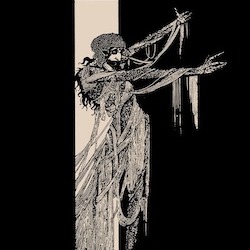
A young sailor (Dennis Hopper) strolling the boardwalks of Malibu while on shore leave offers the viewer an opening glimpse into the film’s metaphysical wormhole, and a not so subtle hint of the director’s queer eye, stalking his virginal prey in the viewfinder. A beachfront entertainment venue is, after all, where one would casually encounter soothsayers and murderers, sea witches and perverts, as the guileless Johnny does, seemingly oblivious to the surrealist elements of his surroundings as he makes his way on land.
Harrington’s carnival-themed underworld is both imaginatively and convincingly presented as a quaint slice of post-war America, effortlessly dovetailing with his intended drive-in audience’s expectations of grind house with a dash of glamor—not to mention his own avant-garde leanings, which remain firmly intact despite Night Tide’s outwardly conventional construction and narrative.
Harrington is able to present this juxtaposition of kitsch Americana and the queer arcana of his occult fascinations. Indeed, Night Tide’s lamb-to-the-slaughter protagonist could have wandered off the set of Fireworks, Kenneth Anger’s 1947 homoerotic short film about a 17-year-old’s sadomasochistic fantasies involving gang rape by leathernecks.
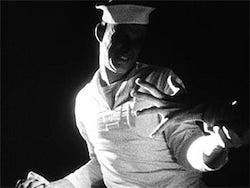
Anger would later sum up his earliest existing film as “A dissatisfied dreamer awakes, goes out in the night seeking a ‘light’ and is drawn through the needle’s eye. A dream of a dream, he returns to bed less empty than before.” Harrington (a frequent collaborator of Anger in his youth) seems to have re-worked Fireworks, or at least its underlying queer aesthetic into a commercially viable feature film that explores his own life long occult fascinations.
Both Anger and his former protégé would view the invocation of evil as a necessary step towards the attainment of a higher level of consciousness. Harrington coaxed a more familiar story from the myths and archetypes that informed his unworldly views for a wider audience; a move that would be later interpreted by sundry cohorts as selling out. Still, Night Tide shares a thematic kinship with Anger’s more obtusely artistic output as acknowledged by the surviving occultist, who confirmed this unholy covenant at Harrington’s funeral by kissing his dead friend on the lips as he laid in his open coffin.
The hokey innocence of Dennis Hopper as Johnny Drake in his tight, white sailor suit casts a homoerotic hue on the impulses that compel him to navigate a treacherous dreamscape to satisfy a carnal longing, just as Anger’s dissatisfied dreamer obeys the implicit commands of an unspeakable other to seek out forbidden pleasures.
As he makes his way on land, the solitary, adventure-seeking Johnny will be lured into a waiting photo booth, his features slightly menacing behind its flimsy curtain, and brightly smiling a second later as the flash illuminates them. Johnny has entered a realm where intersecting worlds collide, delineating light from shadow, consciousness from unconsciousness. The young sailor’s maiden voyage into the uncharted waters of his subconscious is made evident in the contrasting interplay captured by the camera, where predator and prey overlap in darkness. Here, too, we get a prescient preview of the deranged psychopath Hopper would subsequently personify in later roles, most significantly as the oxygen deprived Frank of Blue Velvet—a man who seems to be drowning out of water. But here, Hopper convincingly (and touchingly) portrays a wide-eyed naïf, still unsteady on his sea legs as he negotiates dry land.
As a variation of Anger’s lucid dreamer in Fireworks (and later Jeffrey of Blue Velvet) Johnny will have abandoned himself quite literally (as his departing shadow on a carnival pavilion suggests, before its host blithely follows) to his own suppressed sexual urges; a force that eventually compels him towards denouement.
Moments later, inside the Blue Grotto where a flute-led jazz combo is in progress, Johnny spots a beautiful young woman (Linda Lawson) seated directly across from him. Her restrained and almost involuntary physical response to the music mimic his own, offering the first indication of a gender ‘other’ residing in Johnny; an entombed apparition cleaved from the sub-conscious and projected into his line of vision. Roderick and Madeline Usher loom large in Harrington’s screenplay and Usher’s trans themes lurk invisibly in the subtext. Harrington is arguably heir apparent to Poe’s vacated throne, pursuing similar clue-laden paths and exploring the dual nature of human and the primordial creature just beneath the surface poised to devour its host.
The near literal strains of seductive Pan pipes buoyed by the ‘voodoo’ percussion sets the stage for Harrington’s reworking of the ancient legend of sea-based seductresses and the sailors they lure to their graves.

Marjorie Cameron (or ‘Cameron’ as she is referred to in the opening credits) makes a startling entrance into The Blue Grotto as an elder of a lost tribe of mermaids seeking the return of an errant ‘mermaid’ to her rightful place in the sea. Cameron, a controversial fixture in L.A.’s bohemian circles and one-time Scarlet Women in the mold of Aleister Crowley’s profane muses, would later appear in Anger’s The Inauguration of the Pleasure Dome, and as the subject of Harrington’s short documentary The Wormwood Star (1956).
The inclusion of a bonafide witch, along with a host of less apparent occult/avant-garde figures, is further evidence of Night Tide’s true aspirations and its filmmaker’s subversive intent to sneak an art-house film into the drive-in, and introduce its audiences to the heretical doctrine that had spawned a new generation of occult visionaries influenced by Edgar Allan Poe. Decades later, David Lynch would carry that proverbial torch, further illuminating the writhing, creature-infested realm underlying innocence.
Johnny approaches the young woman who rebuffs his attempts at conversation, seemingly entranced by the music, but allows him to sit, anyway. Soon they are startled by the presence of a striking middle-aged woman (‘Cameron’) who speaks to Johnny’s companion Mora in a strange tongue. Mora insists that she has never met the woman before, nor understands her, but makes a fearful dash from the club as Johnny follows her, eventually gaining her trust and an invitation the following day for breakfast.

Mora lives in a garret atop the carousal pavilion at the boardwalk carnival where she works in one of the side show attractions as a “mermaid.” Arriving early for their arranged breakfast, her eager suitor strikes up a conversation with the man who runs the Merry-Go-Round with his granddaughter, Ellen (Luanna Anders). Their trepidation at the prospecting Johnny becoming intimately acquainted with their beautiful tenant is apparent to all except Johnny himself, who is even more oblivious to Ellen’s wholesome and less striking charms. Even her name evokes the flat earth, soul-crushing sensibilities of home and hearth. Ellen Sands is earthbound Virgo eclipsed by an ascendent Pisces. (Anders would have to subordinate her own sex appeal to play this mostly thankless “good girl” role. She would be unrecognizable a few years later as a more brazenly erotic presence in Easy Rider, helping to define the Vietnam war counterculture era.)
As Johnny ascends the narrow staircase leading to Mora’s sunlit, nautical-themed apartment, he almost collides with a punter making a visibly embarrassed retreat from the upper floor of the carousel pavilion. Is Johnny unknowingly entering into a realm of vice and could Mora herself be a source of corruption? Her virtue is further called into question when she not so subtly asks Johnny if he has ever eaten sea urchin, comparing it to “pomegranate” lest her guest fails to register the innuendo that is as glaring as the raw kipper on his breakfast plate. Johnny admits that he has never eaten the slippery delicacy but “would like to try.” Moments later, Mora’s hand in close-up is stroking the quivering neck of a seagull she has lured over with a freshly caught fish, sealing their carnal bond.
Their subsequent courtship will be marred by an ongoing police investigation into the mysterious deaths of Mora’s former boyfriends, and her insistence that she is being pursued by a sea witch, seeking the errant mermaid’s return to her own dying tribe. Her mysterious stalker will make another unwelcome entrance after her first appearance in the Blue Grotto—this time at an outdoor shindig where the free-spirited young woman reluctantly obliges the gathered locals who urge her to dance. The sight of ‘Cameron’ observing her in the distance causes the frenzied, seemingly spellbound dancer to collapse, setting off a chain of events that will force Johnny to further question her motives and his own sanity.
Mora’s near death encounter through dance is an homage of sorts to another early Harrington collaborator and occult practitioner. Experimental filmmaker Maya Deren had authored several essays on the ecstatic religious elements of dance and possession, and later went on to document her experiences in Haiti taking part in ‘Voudon’ rituals that would be the basis of a book and a posthumously released documentary both titled Divine Horsemen: The Living Gods of Haiti. Note the Caribbean drummers whose ‘unnatural’ presence, in stark contrast to the more typical Malibu beach party celebrants, hint at the influence of black magic impelling the convulsive, near heart-stopping movements that eventually overtake her ‘exotic’ interpretive dance.

The opening sequence of Divine Horsemen includes a woodblock mermaid figure superimposed over a ‘Voudon’ dancer. The significance of this particular motif was likely known to Harrington, a devotee of this early pioneer of experimental American cinema. Deren herself appeared as a mermaid-like figure washed ashore in At Land (1947) who pursues a series of fragmented ‘selves’ across a wild, desolate coastline. Lawson with her untamed black hair and bare feet could be a body double of Deren’s elemental entity traversing unfamiliar physical terrain to find a way back to herself.
Mora’s insistence that she is being shadowed by a malevolent force directly connected to her mysterious birth on a Greek Island and curious upbringing as a sideshow attraction compel Johnny to investigate her paranoid claims, hoping to allay her fears with a logical explanation for them. The sea witch (or now figment of his imagination) will guide the sleuthing sailor into a desolate, mostly Mexican neighborhood where her departing figure will strand him—right at the doorstep of the jovial former sea captain who employs Mora in his tent show as a captive, “living, breathing mermaid.”
The British officer turned carnie barker is in a snoring stupor when Johnny first encounters him, snapping unconsciously into action to give a rote spiel on the wonders that await inside his tent. Muir balances Mudock’s feigned buffoonery with a slightly sinister edge. When Johnny arrives at his doorstep to find out more about the ongoing police investigation into her previous boyfriend’s deaths, the captain’s effusive hospitality takes on a decidedly darker tone when he guides his visitor to his liquor/curio cabinet where a severed hand in formaldehyde, “a little Arabian souvenir,” is cunningly placed where Johnny’s will see it. The spooky appendage serves as a reminder to Mora’s latest suitor of the punishments in store for a thief.
Captain Murdock’s Venice beach hacienda is yet another one of Night Tide’s deviant jolts: a fully fleshed out character in itself that speaks of its well-travelled tenant’s exotic and forbidden appetites. The dark, symbol-inscribed temple Johnny has entered at 777 Baabek Lane could be a brick-and-mortar portal into this mythic, mermaid-populated dimension that Johnny’s booze-soaked host thunderously defends as real.
Before falling into another involuntary slumber, Murdock will try to convince Johnny that while he and Mora merely stage a sideshow illusion, “Things happen in this world”—or, more to the point, Mora’s belief that she is a sea creature is grounded in fact.
Murdock’s business card that Johnny handily has in his pocket while tailing his dramatically kohl-eyed mark is oddly inscribed with an address more likely to be an ancient Phoenician temple of human sacrifice (Baalbek) than a Venice Beach bungalow. A lingering camera close-up offers another tantalizing, occult-themed puzzle piece—or perhaps a deliberate Kabbalah inspired MacGuffin. The significance of numbers as the underlying components for uniting the nebulous and intangible contents of the mind with the more inert, gravity bound matter, existing outside it, as the ancient Hebrews believed, wouldn’t have been lost on Night Tide’s mystically-minded helmer. Mora’s explicitly expressed disdain for Johnny’s view of the world as a rationally ordered, measurable entity that could be mathematically explained, reinforces Harrington’s world view, his love of Poe, and those French Symbolist artists who interpreted him.
In Odilon Redon’s Germination (1879), a wan, baleful, free-floating arabesque of heads of indeterminate gender suggests either a linear, ascending involution, or a terrifying descent from an unlit celestial void into a bottomless pit of an all-too-human, devolving identity. Redon’s disembodied heads gradually take on more human characteristics, culminating into a black-haloed portrait in profile. The cosmos of Redon’s etching is governed by an unexplained, inexplicable moral sentience, which absorbs the power of conventional light. Thus black is responsible for building its essential form, while glimmers of white, hovering above and below, prove ever elusive; registering as somehow elsewhere, beyond the otherwise tenebrous unity of the picture plane.
Night Tide has its own unsettling dimensions, of course, this black-and-white boardwalk where astral, egalitarian bums want to tip-toe; and, somehow, practically all of them do. Not a movie but an ever-becoming place, crammed into low-budget cosmogenesis unto eternity. We won’t discuss the ending here, since it hasn’t happened yet.

by The Lumière Sisters
18 notes
·
View notes
Link

1. The Magus, Magician, or Juggler, the caster of the dice and mountebank, in the world of vulgar trickery. This is the colportage interpretation, and it has the same correspondence with the real symbolical meaning that the use of the Tarot in fortune-telling has with its mystic construction according to the secret science of symbolism. I should add that many independent students of the subject, following their own lights, have produced individual sequences of meaning in respect of the Trumps Major, and their lights are sometimes suggestive, but they are not the true lights. For example, Eliphas Lévi says that the Magus signifies that unity which is the mother of numbers; others say that it is the Divine Unity; and one of the latest French commentators considers that in its general sense it is the will.
CLASS I
Section 2
TRUMPS MAJOR
OTHERWISE, GREATER ARCANA

3 notes
·
View notes
Text
Spell: Phantasmal Killer
You may be wondering why I’m discussing another non-Sorcerer spell.
Answer: it is one in 3.x and 5e’s spell lists are annoyingly limited. (I mean, why isn’t it a Sorcerer spell? It’s a boom boom spell and they get mostly those -- and it’ll probably be one officially if WotC continues in the direction of its last psionics playtest.)
This spell’s description is unchanged between editions, but its mechanics are vastly different:
5e: As the 3.5 version of mind thrust (1d10 psychic damage per level of the spell slot used, Wis negates), but as a 4th-level DoT (concentration, up to one minute) that also comes with the Frightened status.
If you concentrate for the full duration and the subject doesn’t succeed on any of its saves (initial + one at the end of each of its turns), you could deal 10 x Xd10, where X is the spell slot’s level. That’s a lot more damage.
3.x: An illusion that will kill your target if they fail their save or deal irresistible damage on a success, but with many drawbacks.
What are the drawbacks of the 3.x version?
It’s an Illusion (Phantasm) [Fear, Mind-Affecting]. That’s four pathways for resistance or immunity; resistance or immunity to fear is particularly common and five creature types are immune to mind-affecting effects (Construct, Ooze, Plant, UNDEAD, and Vermin).
One of the spell’s advantages is that it’s a save-or-die spell without the Death descriptor.
Spell Resistance applies.
Because 3.5′s mechanics try to simulate effects (sometimes at the expense of gameplay), the target gets two saves: a Will save to disbelieve an illusion with which it’s interacting (your conjured Freddie Krueger has to touch them) and a Fortitude save against death (the implied heart attack for not disbelieving the illusion).
There aren’t many classes or creatures which don’t have good Fort or Will saves. Most of those are Rogue variants.¹ Otherwise, you’ve got Commoners, Elemental-type creatures (3.5) with the Air or Fire subtypes, many (but not all) Humanoid creatures in 3.5 (but not 3.P), and four splatbook classes.²
If the subject succeeds at disbelieving the Illusion and has telepathy, they can turn the spell back on the caster, who has to make the Will vs. Disbelief save even though they cast the spell in the first place.
You tend to find telepathy on Aberrations, Outsiders (except Celestials, who generally get tongues/Truespeech instead), and specifically psionic creatures of other types, but it’s sprinkled all over: nightshades, pseudodragons (and faerie dragons), and a variety of other creatures have it.
There’s also the helm of telepathy, which the spell specifically mentions.
It’s like with Cait Sith in Final Fantasy VII: I’ve always wanted to play with it, but the risk of accidentally killing myself isn’t one I want to accept.
Conclusion: find a way of taking it in 5e.
¹ Mountebank (Dragon Compendium; a Rogue/Warlock blend), Ninja (both versions, but the Complete Adventurer one gets +2 on Will saves so long as it retains ki points in its ki pool), Psychic Rogue (unlike Lurk or Spellthief, which have good Will saves), regular Rogue, Scout, and Pathfinder Swashbuckler.
² Battle Dancers (Dragon Compendium, a so-so Chaotic Monk), Factotums (Dungeonscape), and some generic Spellcasters and Warriors (Unearthed Arcana). The generic classes choose their good and bad saves, but only the Expert gets two good saves.
10 notes
·
View notes
Text
Sanders Sides Major Arcana
So I made an entire Major Arcana today, themed around Sanders Sides. I made a Minor Arcana first, because I am using (and deriving some things) from the Geneverse Tarot on which I based a lot of cards. It was the first time I drew Talyn, Joan, Valerie and Dahlia too!
@thatsthat24
@tallykat3
@thejoanglebook
@randomslasher
@thebaagelboy
@gingermachiatto
@thelilkiwibird

0 - The Fool
I pictured Thomas in this card. He’s walking with his eyes closed, but he doesn’t see he’s at a very dangerous cliff. His jewel (right there next to his neck) is white, signifying he’s a beginner. This card is numero 0 in almost every deck; (in some it is 22) and it is a card of purity, innocence and not knowing much in general. But instead of it being pictured as something dumb (like the title suggests) it is put as being a blank slate.
Music - With Pearly (reminds me of the innocence of the Fool)

I - The Magician/Bateleur/Mountebank
Logan is pictured on this card. Instead of a wand, a cup, a pentacle and a sword he is holding up the alchemistic symbols in his hands (from left to right: Fire, Air, Earth and Water). He is walking, as these things are always moving in infinity (the symbol he is standing on). The earth behind him does not have any vegetation - yet.
Music - Rustless Fall (Sounds simply magical and like it would belong in Portal)

II - The (High) Priestess/Papesse
I needed for the next two cards two female characters. Here’s Thomas’ friend Dahlia as the High Priestess. She sits between the two pillars of the old temple, named Boaz and Jachin. One of them is black with a white dot; the other is white with a black dot - this references Yin and Yang. Dahlia is sitting on a throne and the moon is on the throne and also on her outfit. Together with the fact I placed her also above a body of water, means that she is ruling over the subconscious. Dahlia holds a perchment in her hands and she is sitting in front of a curtain. The red spots are actually pomegranates (I can’t draw them), the fruit Persephone ate and She was doomed.
Music - Sis Puella Magica (Light Instrumental Remix)

III - The Empress
I sketched this one last. I knew the Empress was going to be hard to pick someone for, especially since I picked Dahlia for the previous card. But I decided on drawing Valerie. She is sitting in (my approximation of) a forest, and she is holding a female sign in her hands. The Empress is strongly associated with female power, the Anima and mothership.
Music - Darling Kanaya (A dead ringer for this card)
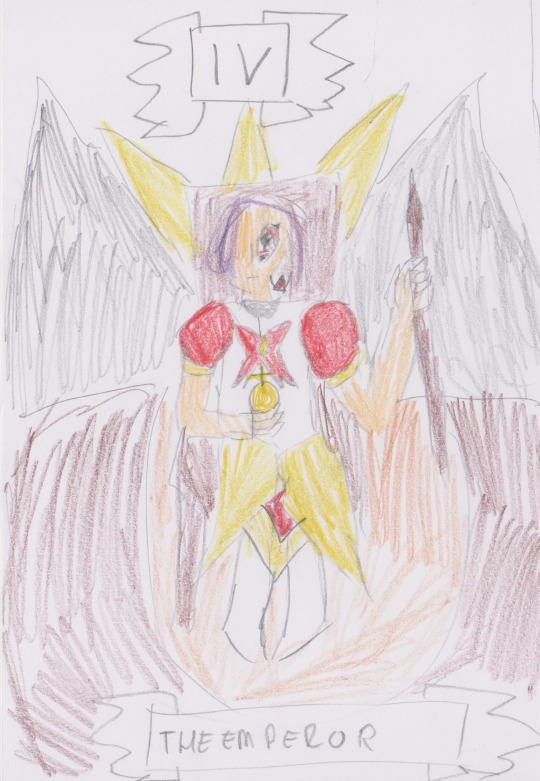
IV - The Emperor
Roman sitting on a throne in the mountains. In tarot, mountains are a usual male symbol (don’t ask me why). He is holding regalia in his hand and a wand - a traditional fire symbol. His throne mimicks the rays of the sun. He is sitting calmly and has a stern expression. This card is the opposite of the Empress - Male power, the father figure and authority. It is associated with Aries (Aradia) and since it is a Fire sign, I put Roman in here.
Music - Requiem of Sunshine and Rainbows

V - The Hierophant
Joan, with a key in hand and their other hand raised in benediction, sitting in front of Thomas (left) and Talyn (Right). A card of methods that are tried and still hold true, tradition and status quo, should be taken as a whisper of ‘Don’t do it now.’ to you when it comes to trying out new things. It is associated with Taurus (Tavros).
Music - Salv8tion (Repetitive and the voices gave me a church vibe)

VI - The Lovers
Joan once said they shipped themselves with Talyn and because I’m not a shipper when it comes to Sanders Sides (when it comes to things other than that...they are...different so to speak) has this card has Talyn and Joan. Talyn’s more busy staring at their phone than watching Joan, but has one arm around Joan’s leg to keep them grounded. Talyn is holding Joan, who is pointing at the sky - a representation of the journey from the conscious mind, to the subconscious to the superconscious. This card is not only about love, but also about harmony, unity and - often - choice. The tree in the background is to recall a little from the Raider - White card. It is associated with Gemini (Sollux).
Music - Lilith in Starlight (two-sided waltz; picks up in rhythm in the middle part to return to a waltz rhythm at the end)
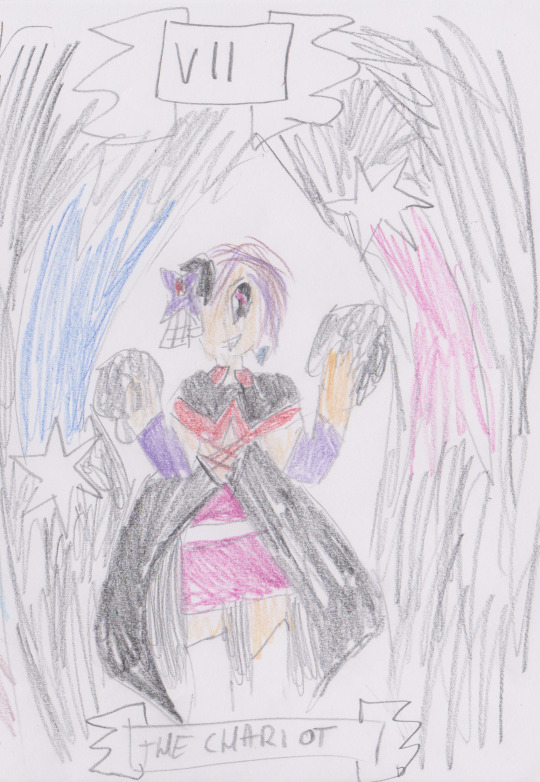
VII - The Chariot
Virgil isn’t the first Side you’d think of if you know what the Chariot entails: victory, motion, willpower. However, since this card is associated with Cancer (Karkat) and it is a Water Sign, I put in Virgil. The stars represent the celestial forces at work. Have a rare smiling Virgil - but it is no happy smile, it is a ‘Get out of my way’ smile. He is not making his way by rough power, but with powers from his mind, as you can see at his hands.
Music - Orange Hat/Breakdown (Badass fighting theme)

VIII - Justice/Adjustment
I know you’re just dying to see Strength in the place where I put Justice. Before you yell at me - I have two reasons for doing this.
1. Justice was card 8 before Aleister Crowley made a change;
2. I am a huge fan of the series Puella Magi Madoka Magica, which has a lot of Tarot symbology in it and it features heavy themes of Justice (albeit reversed) in episode 8.
Alright, Justice. It’s the card of the concept of Karma. Patton is blindfolded much like the actual Lady Justice. He is holding a scale weighting the Feather of Truth and a heart. Egyptian mythology says your heart is weighted with the Feather of Truth to decide where you go. In his other hand, he is holding a yellow sword with purple inscriptions in it, which is the symbol for Air. Also, what are backgrounds. It is associated with Libra (Terezi) and because it is an Air sign, have a Patton.
Music - Delta Divination (Fluctuating, as if deciding a verdict)

IX - The Hermit
Let me tell you a thing. I planned Logan for this card even before remembering it is associated with Virgo (Kanaya) which is an Earth Sign. This card represents solitude, meditating and a quiet moment before getting back on track and kicking a few asses. Logan is clothed in a covering robe here, suggesting invisibility.
Music - Darkened Streets (Picture yourself in a cave when listening to this)

X - The Wheel of Fortune/Chance
Named ‘Chance’ for brevity and also to mimick the Geneverse tarot card, this card was also a bitch to make. Why does it have to have so much to draw on it? This translated to all four Sides. Virgil as the one who rests at the depth, Roman as the one who always strifes to get higher. Logan and Patton rotate between them. This card is a card of, you know, Chance, but also inevitable fate and changing things. Oh, and cycles. That too.
Music - Puella in Somnio (Listen to it. It goes on. Forever repeating.)

XI - Strength/Lust
Strength, the card you’ve been waiting for when you were staring at card 8 instead. This card was a little hard. The beast, or often lion, represents inner animalistic tendecies everyone has. And because I cannot draw lions, I needed a substitute - and it became Roman. It is associated with my Sign, Leo (Nepeta), which is a Fire Sign so it needed to have Roman in it anyway. The Side of Thomas’ Ego and masculinity. He stands in front of Patton, sword drawn but he does not attack him. Patton is standing there, showing no signs of panic, and is simply holding up his hand closest to Roman, as in to say ‘Stop, no further’ but also ‘Okay, stay there.’ as in a calm way.
Music - Oolongcat (A calm track, as the titular strength is no physical strength)

XII - The Hanged Man
Thomas is hanging upside down, his hair is being ruined and all the blood’s streaming to his head. That can’t be healthy. Yet he is completely calm. He is tied on a tree with a red rope symbolizing human desire, and because his other leg is tucked behind it, he makes a reverse ‘4′. His jewelry (Tiara, hanger and the thing he wears on his chest) is on the ground, as they probably won’t stay on when hanging on this card symbolizing self-sacrifice, martyrdom with a cause and change.
Music - Clementia (as to symbolize the calmness he invokes and because it’s the theme of another character associated with this card)

XII - Death
A misunderstood card. This card is representative of a crisis and a large change. Keep in mind: This card in a reading has a 50% of being good if upright in my view. Anyway, Virgil in a yellow bed of red and blue roses. At the bottom two Red Spider Lilies (Lycoris Radiata) grow, as a symbol of seperation, death and meetings that don’t happen again. Virgil is dead in this image and that is why his skin tone is so light, for anyone who has never seen a dead person. It is associated with Scorpio (Vriska) which is a Water Sign, and it’s a coincidence that Virgil is on this card, because I was mainly inspired by the other Virgil tarot card.
Music - Serena Ira (which means ‘Calm Rage’, this music fits the image more than the meaning though)

XIV - Temperance
Talyn was perfect to convey this card, mainly because they’re nonbinary - the angel on the original card was too, as a balance between the genders. That’s because balance is all this card is about - peace and reunion. Talyn is standing with one foot in the water, and one foot at the ground, as if they are testing the water. A triangle box symbol can be seen behind Talyn. It represents them being protected by natural law. And as an extra - the water is actually flowing from bottom to top - as a subconscious mind to a superconscious. It is associated with Sagittarius (Equius).
Music - Calming Quartz (Which I usually associate with Virgil, by the way)

XV - The Devil
Deceit (who was another dead-ringer for this card), together with Roman and Patton who are bound. Their binds to Deceit are not physical, but mental (they’re mind-controlled if the Crocker tier eyes and fucked up color scheme could not tell you). This card is the ultimate Dark Side card. It is a representation of our addiction to things and being bound. This card is also a symbol of materialism. It is associated with Capricorn (Gamzee).
Music - Purple Bard/Paradox Remnant (Which I also regard as a theme for the Dark Sides as a whole)
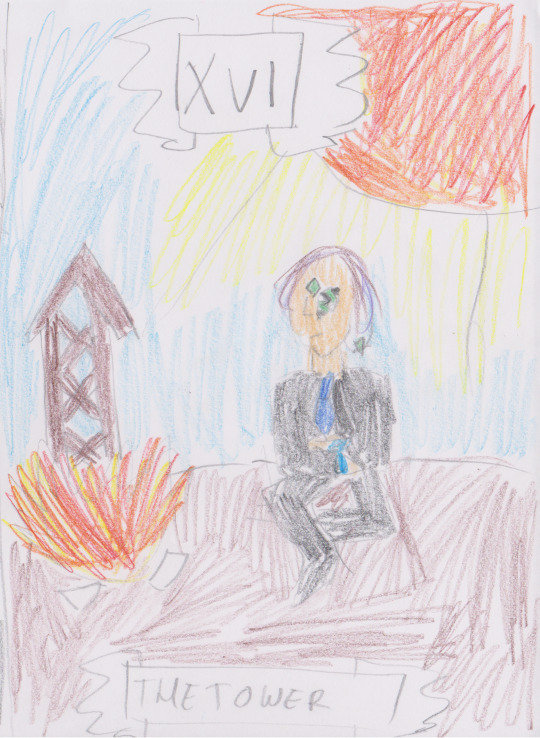
XVI - The Tower
I honestly had no idea who to choose. It became Logan. He is an onlooker in regards to the small tower that is burning. Next to the fire there are two glass shards, which suggests that he burned the tower, using the sun’s rays. He is sitting there calmly. Clearly, he is okay with being on this card that represents disaster and sudden changes, but also chances for starting anew.
Music - Cor Destuctum (’Heart of Destruction’ or ‘Broken Heart’)

XVII - The Star
After the destruction of the tower and everything went down (literally), we see Patton calmly pouring water in a starry sky. The seven stars represent your Chakra’s. This card is a card of hope, rejuvenation and peace. It is associated with Aquarius (Eridan) which is an Air Sign, so here is another Patton.
Music - Desiderium (Signifying the tiny bit of hope left after destruction)
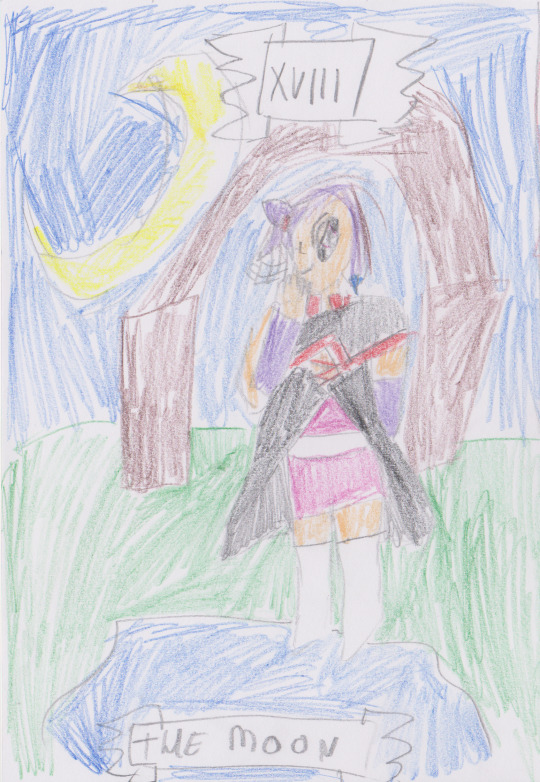
XVIII - The Moon
Virgil and Roman were my last dead-ringers I had. Mainly because this card is representative of mystery, secrets and - you won’t believe me - Anxiety. Virgil is standing half in a pond, half on the ground. He smiles mischievously and the hand also seems to say: ‘Be silent, you’re in my territory now’. His other hand is behind his back, as if he is holding something we are not allowed to know. There is a portal around Virgil, which seems to be leading to a pathway.
Music - Another Episode (Which sounds more magical than anxious)
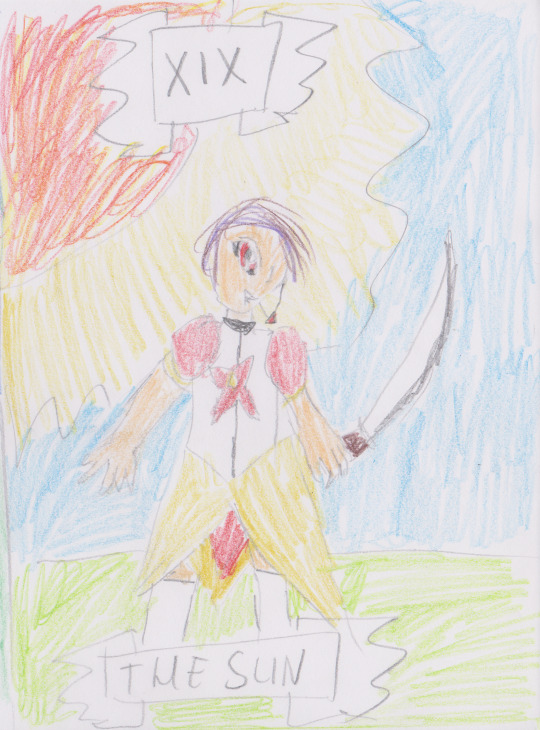
XIX - The Sun
Roman posing with a sword. Everything is bright, and he is ready for whatever comes. This card is a card of positivity, joy and innocence. While Roman does not really embody the last thing, but he does embody several of the things this card is also associated with, which is passion.
Music - Salvae, Terrae Magicae (This really does not need an explanation)
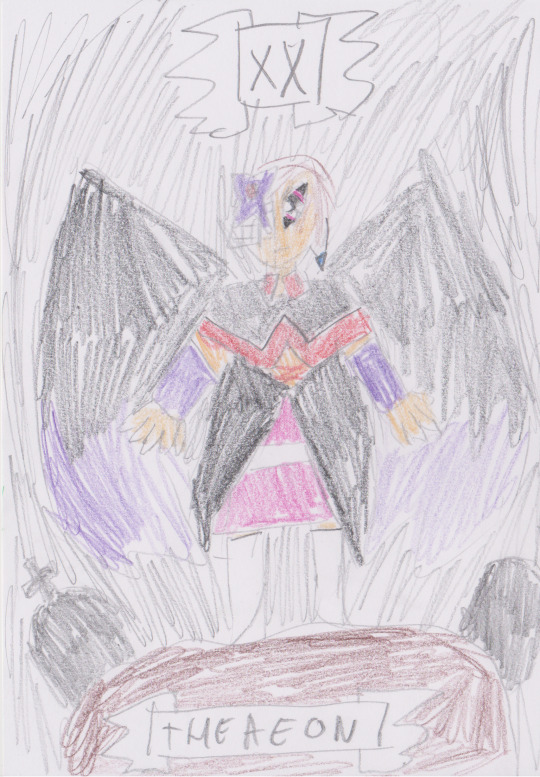
XX - Judgement/Aeon
This card is called the Aeon in here in order to align up the Geneverse Tarot. This was another hard one since it is a card of the final battle, getting up one last time, the final push and I had no idea who to picture as the angel who awakes the dead. I decided to go for Virgil as I just wanted to have drawn a winged Virgil.
Music - Rust Servant/Handmaid of Death (You can see why I chose this - violence warning though)

XXI - The World
This is the card of ‘it’s finally done’. Getting your reward - you earned more than enough. Clockwise, this image shows Virgil, Patton, Logan and Roman’s hands.
Music - Sagitta Luminis
#sanders sides#thomas sanders#tarot#tarot cards#roman snaders#creativity sanders#virgil sanders#anxiety sanders#patton sanders#morality sanders#logan sanders#logic sanders#tsdeceit#joan stokes
20 notes
·
View notes
Text


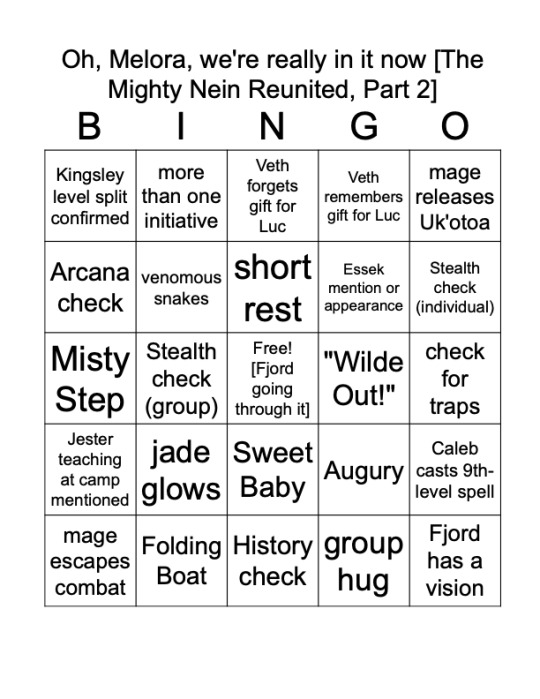
We're really in the thick of it now, huh. Here's a call list for Fjord's No Good, Very Bad Day: 69 items like last time, here's a link to BingoBaker to generate your own card. Notes are as follows:
"Fjord teleports" is for under his own power. Caleb's Teleport, Jester's Word of Recall, or similar do not count. Arcane Gate, if Fjord steps through it himself, DOES count.
"Fjord emotional / upset" is mostly self-indulgence, but this square is intended for something like beyond Fjord's general scope of comfortable display of emotion. Like, this has got to be something really notable on the scale here for him. I'm talking like tears or blind rage level emotion.
Statues or other carvings count toward "mural or other art in temple".
A group hug constitutes at least three people.
Any item listed must be used for it to count.
Sweet Baby is Veth's pistol. It probably doesn't have any bullets left, but who knows what she did in six months.
"Caleb / Jester casts a 9th-level spell" the spell ITSELF must be of 9th-level. An upcast spell does not count for this.
"Fjord / Veth casts a new spell" is for a spell they have not yet cast during the campaign, even if it was before mentioned. Floating Disk was cast in Part 1. Cone of Cold was never cast so counts. Cantrips also count.
"(Mass) Polymorph" is for Mass Polymorph OR Polymorph.
Any spell listed counts even if a hostile casts it, i.e. if squid mage casts Counterspell, the square is legal.
Uk'otoa does not count a venomous snake.
As always, I'm happy to answer your questions about questions during and after the episode and into the week. I also am always happy to see your bingos, almost bingos, and fun rows or columns that you hope happen.
Good luck, and happy primordial sea serpent day.
Veth gives scouting advice
Fjord teleports
venomous snakes
jade glows
Fjord has a vision
Jester teaching at camp mentioned
Yasha "messages" someone
someone hugs Fjord (pls)
Fjord emotional / upset
mage escapes combat
check for traps
mural or other art in temple
mage releases Uk'otoa
Fjord releases Uk'otoa
nobody releases Uk'otoa
snacks
short rest
long rest
more than one initiative
Kingsley level split confirmed
any kiss
group hug
Veth remembers gift for Luc
Veth forgets gift for Luc
Sprinkle
"Wilde Out!"
"dope monk shit"
any horny comment
Cape of the Mountebank
Folding Boat
Fluffernutter
Inescapable Lash
Marvelous Pigments
Sweet Baby
Veth casts new spell
Fjord casts new spell
Caleb casts 9th-level spell
Jester casts 9th-level spell
Adella appearance
Orly appearance
Avantika or Vandran mention
Caduceus mention
Essek mention or appearance
Augury
Counterspell
Locate Object
Misty Step
(Mass) Polymorph
Nein-Sided Tower
Sending / Message
Web of Fire
successful Armor of Hexes
Blood Maledict
Debilitating Barrage
Fury of the Tides
Grim Psychometry
Marine Layer
Radiant Soul
Stunning Strike
Zealous Presence
any Smite
Arcana check
History check
Investigation check
Perception check
Religion check
Stealth check (group)
Stealth check (individual)
Survival check
53 notes
·
View notes
Note
Jagged Stone
Have you spoken to XY since Bob Roth went to jail? Have you reached out to him?
Jagged: After Bob Roth turned himself in and me an’ Penny figured her out, I tried reaching out to the bloke. I’d already figured his cockiness and ego were a façade for somethin’... I just didn’t know what...
Jagged: Well, if I’m given the opportunity, and should he be a better person now, I wouldn’t mind a fresh start with ‘im!
Penny: It’ll probably be a while, though. Xaver has a lot to sort out first, doesn’t he?

#RYVAL#Miraculous Ladybug#Persona 5#Persona#Jagged Stone#Mountebank Arcana#Xaver Yakup Roth#Xavier-Yves Roth#Lightning Arcana#Penny Rolling
5 notes
·
View notes
Text
WHO YOU CAN ASK TO RAISE THEIR VOICE:
WARNING - CONTAINS SPOILERS!
THIS WILL BE UPDATED!
THIS FIC OPERATES UNDER THE VANILLA TIMELINE WITH TINY ASPECTS OF PERSONA 5 ROYAL, NOT THE ROYAL TIMELINE!
PLZ DO NOT ASK ANY QUESTIONS TO THE AUTHORS OR ANY CHARACTERS NOT STATED BELOW UNLESS IT’S IMPORTANT (TYPOS, ERRORS, ETC.)! FOR THAT STUFF, MESSAGE US!
ALSO, PLEASE DON’T ASK QUESTIONS THAT MAY CONSTITUTE AS SPOILERS!
FURTHERMORE, WE RESERVE THE RIGHT TO NOT ANSWER A QUESTION!
Akira Kurusu/Kujaku/Joker - The Fool Arcana
Birthday: June 8th.
Morgana/???/Mona - The Magician Arcana
Birthday: April 11th.
Ryuji Sakamoto/Saruchame/Skull - The Chariot Arcana
Birthday: July 3rd.
Ann Takamaki/Bombshell/Panther - The Lovers Arcana
Birthday: November 12th.
Yusuke Kitagawa/Kijutsu-shi/Fox - The Emperor Arcana
Birthday: January 28th.
Makoto Niijima/Mitsubachi/Queen - The Priestess Arcana
Birthday: April 23rd.
Futaba Sakura/???/Oracle - The Hermit Arcana
Birthday: February 19th.
Haru Okumura/Madame Nezumi/Noire - The Empress Arcana
Birthday: December 5th.
Shiho Suzui/Hou-ou/Rise - The Thunderbolt Arcana
Birthday: March 4th.
Yuuki Mishima/Great Dane/Ace - The Moon Arcana
Birthday: September 3rd.
Goro Akechi/?/? - The Justice Arcana
Birthday: June 2nd.
Marinette Dupain-Cheng/Ladybug/Chance - The Luck Arcana
Luka Couffaine/Kobra/Viper - The Adam Arcana
Nino Lahiffe/Shadow Barb/Beat - The Artisan Arcana
Alix Kubdel/Bunnix/Jack - The Archangel Arcana
Kagami Tsurugi/Dragonica/Ryūko - The Eve Arcana
Lê Chiến Kim/Yanbian/King - The Captain Arcana
Nathaniel Kurtzberg/Ibex/Red - The Cobbler Arcana
Juleka Couffaine/La Prédatrice/Gem - The Sorcerer Arcana
Marc Anciel/Phacochère/Smith - The Alchemist Arcana
Adrien Agreste/Chat Noir/Rogue - The Chagrins Arcana
Lionel Garçon - The Creation Arcana (Judgement)
Xaver “Xavier-Yves” Roth - The Lightning Arcana (Tower)
Jagged & Penny Stone-Rolling - The Mountebank Arcana (Magician)
Alya Césaire - The New Vision Arcana (Hanged Man)
Tom Dupain & Sabine Cheng - The Folly Arcana (Fool)
André Bourgeois - The Speaker Arcana (Hierophant)
Other Social Links (DO NOT SEND QUESTIONS FOR THEM):
Igor - The Fool Arcana
Takuto Maruki - The Councillor Arcana
Duusu - The Existence Arcana (Magician)
Yukiko Amagi-Satonaka - The Popess Arcana (Priestess)
Sojiro Sakura - The Hierophant Arcana
Chie Amagi-Satonaka - The Dissension Arcana (Chariot)
Chihaya Mifune - The Fortune Arcana
Caroline & Justine - The Strength Arcana
Munehisa Iwai - The Hanged Man Arcana
Tae Takemi - The Death Arcana
Sadayo Kawakami - The Temperance Arcana
Ichiko Ohya - The Devil Arcana
Shinya Oda - The Tower Arcana
Hifumi Togo - The Star Arcana
Toranosuke Yoshida - The Sun Arcana
Sumire Yoshizawa - The Faith Arcana
#RYVAL#Persona 5#Miraculous Ladybug#Persona#Akira Kurusu#Morgana Persona 5#Ryuji Sakamoto#Ann Takamaki#Yusuke Kitagawa#Makoto Niijima#Futaba Sakura#Marinette Dupain-Cheng#Luka Couffaine#Nino Lahiffe#Alix Kubdel#Kagami Tsurugi#Lê Chiến Kim#Nathaniel Kurtzberg#Shiho Suzui#Juleka Couffaine#Haru Okumura#Yuuki Mishima#Marc Anciel#Adrien Agreste#Goro Akechi
20 notes
·
View notes
Photo

CLASS I
§ 2
TRUMPS MAJOR
Otherwise, Greater Arcana
1. The Magus, Magician, or juggler, the caster of the dice and mountebank, in the world of vulgar trickery. This is the colportage interpretation, and it has the same correspondence with the real symbolical meaning that the use of the Tarot in fortune-telling has with its mystic construction according to the secret science of symbolism. I should add that many independent students of the subject, following their own lights, have produced individual sequences of meaning in respect of the Trumps Major, and their lights are sometimes suggestive, but they are not the true lights. For example, Éliphas Lévi says that the Magus signifies that unity which is the mother of numbers; others say that it is the Divine Unity; and one of the latest French commentators considers that in its general sense it is the will.
Source: https://www.sacred-texts.com/tarot/pkt/pkt0102.htm
8 notes
·
View notes
Text
Gnostic Boardwalk
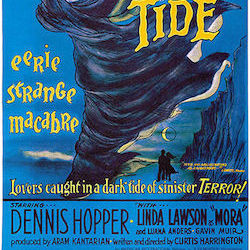
Canonical stature is a fragile and contingent thing, which is why powerful institutions seek to shore up the various canons of art with rankings and plaudits. We’ll play along by asserting that one of our favorite “B” movies was originally screened by Henri Langlois at the Cinematheque française with Georges Franju in attendance. Night Tide (1961) was an unlikely contender for this particular honor—shot guerrilla style on an estimated $35,000 budget, and intended, by its distributors at least, for a wider, less demanding audience seeking mostly air-conditioned escapism.
With its hinky cast—nonfictional witch, Marjorie Cameron; erstwhile muse to surrealist filmmaker Jean Cocteau, the undersung Babette who usually appears en travesti; and lecherous, booze-addled, fresh-faced Hollywood castoff Dennis Hopper—Night Tide invades the drive-in. A tarot reading at the film’s heart gives Marjorie Eaton her time to shine, traipsing into nickel-and-dime divination from her former life as a painter of Navajo religious ceremonies. Linda Lawson might have issued from an etching by Odilon Redon, with her raven locks and spiritual eyes, our resident sideshow mermaid. Not surprisingly and despite such gentle segues, the film itself traveled a rocky road from festivals to paying venues.
Night Tide had spent three years languishing in the can when distributor Roger Corman smuggled the unlikely masterwork into public consciousness, another of his now legendary mitzvahs to art. And the sleazy-sounding double bills that resulted also unleashed an aberrant wonder: the movie’s compact leading man, a force previously held captive by the studio system—looking, here, like some homunculus refugee from the Fifties USA. Dennis Hopper, in his first starring role, would later recall that it represented his first "aesthetic impact" on film since his earlier appearances in more mainstream productions such as Rebel Without a Cause and Giant had denied him meaningful outlets for collaboration.
It’s the presence of its featured players—certainly not their star power—that lends the film its haunting and enduring legacy, and elevates the term “cult classic” to its rightful place in the pantheon of cinema. But we argue that Night Tide remains outside these exclusive parameters—upholding an elsewhere-ness that defies commercial, if not strictly canonical, logic. Curtis Harrington’s first feature film escapes taxonomy, typology or genre—gets away—fueling itself on acts of solidarity instead. If Hopper contributes his dreamy aura, then Corman rescues the seemingly doomed project by re-negotiating the terms of a defaulted loan to the film lab company that was preventing the film’s initial release. His generous risk birthed a movie monument that would add Harrington’s name to a growing collection of talent midwifed by the visionary schlockmeister responsible for nursing the auteurs of post-war American cinema. And here we enter a production history as gossamery as Night Tide itself.
Unlike his counterparts entrenched within the studio system, Harrington was an artist -- i.e. a Hollywood anachronism, with aristocratic graces and a viewfinder trained on the unseen. We see Harrington as Georges Méliès reborn with a queer eye, casting precisely the same showman’s metaphysics that spawned cinema onto nature. By the time moving pictures were invented, artists were moving away from a bloodless representational ethos and excavating more primordial sources for inspiration. The early stirrings of what surrealist impresario André Breton would later proclaim: “Beauty will be CONVULSIVE or it will not be at all.”
Harrington owned a pair of Judy Garland’s emerald slippers, and according to horror queen/cult icon Barbara Steele, also amassed an eclectic array of human specimens: “Marlene Dietrich, Gore Vidal, Russian alchemists, holistic healers from Normandy, witches from Wales, mimes from Paris, directors from everywhere, writers from everywhere and beautiful men from everywhere.” On a hastily constructed Malibu boardwalk, Hopper would be in his milieu among the eccentric denizens of California’s artistic underground—most notably, Harrington himself, a feral Victorian mountebank of a director who slept among mummified bats, practiced Satanic rites, and hosted elaborate and squalid dinner parties. One could almost picture the mostly television director in his twilight years as Roman Castavet of Rosemary’s Baby; a spellbinding raconteur with a carny’s flair for embellishment and enticement. Enthralled by the dark gnosticism of Edgar Allan Poe that had started when the aspiring 16-year-old auteur mounted a nine-minute long production of The Fall of the House of Usher (1942), Harrington would embark on a checkered film career that combined his occult passions with the quotidian demands of securing steady employment. Night Tide, a humble matinee feature whose esoteric underpinnings would spawn subsequent generations of admirers, united the competing forces of art and commerce that Harrington would struggle with throughout his career. Like Méliès, Harrington pointed his kinetic device towards the more preternatural aspects of early motion pictures to seek out the ‘divine spark’ that Gnostics attribute to transcendence, and the necessary element to achieve that immortal leap into the unknown. What hidden meanings and unspeakable acts Poe had seized upon in his writing were brought infernally to life with a mechanical sleight-of-hand. It was finally time for crepuscular light, beamed through silver salts to illuminate otherworldly and other-thinking subjects.
By the time Harrington had embarked on his feature film debut, a more muscular celluloid mythology based on America’s proven exceptionalism was in full force, taking on a brutalist monotone cast in keeping with the steely-eyed, square-jawed men at the helm of a nascent super-power, consigning its more feminine preoccupations to the dusty vaults where celluloid is devoured by its own nitrate. Harrington would resurrect the convulsive aspects of his chosen vocation and embed them deep within the monochrome canvas he’d been allotted for his first venture into feature filmmaking, and combine them with the more rational aspects of so-called realism. In the romantic re-telling of a familiar myth, Harrington was remaining true to gnostic roots and the distinctly poetic language used to express its cosmological features.
In Night Tide, Harrington would map the metaphysical terrain that held up Usher’s cursed edifice as a blueprint for his own work that similarly explored the intertwined duality of the natural and the supernatural. The visible cracks that reveal a fatal structural weakness and a loss of sanity in both Roderick Usher and his doomed estate are evident in Night Tide’s conflicted heroine compelled to choose between her own foretold death underwater, or a worse fate for those who fall in love with her earthly human form.
A young sailor (Dennis Hopper) strolling the boardwalks of Malibu while on shore leave offers the viewer an opening glimpse into the film’s metaphysical wormhole, and a not so subtle hint of the director’s queer eye, stalking his virginal prey in the viewfinder. A beachfront entertainment venue is, after all, where one would casually encounter soothsayers and murderers, sea witches and perverts, as the guileless Johnny does, seemingly oblivious to the surrealist elements of his surroundings as he makes his way on land.
Harrington’s carnival-themed underworld is both imaginatively and convincingly presented as a quaint slice of post-war America, effortlessly dovetailing with his intended drive-in audience’s expectations of grind house with a dash of glamor—not to mention his own avant-garde leanings, which remain firmly intact despite Night Tide’s outwardly conventional construction and narrative.
Harrington is able to present this juxtaposition of kitsch Americana and the queer arcana of his occult fascinations. Indeed, Night Tide’s lamb-to-the-slaughter protagonist could have wandered off the set of Fireworks, Kenneth Anger’s 1947 homoerotic short film about a 17-year-old’s sadomasochistic fantasies involving gang rape by leathernecks.
Anger would later sum up his earliest existing film as “A dissatisfied dreamer awakes, goes out in the night seeking a ‘light’ and is drawn through the needle’s eye. A dream of a dream, he returns to bed less empty than before.” Harrington (a frequent collaborator of Anger in his youth) seems to have re-worked Fireworks, or at least its underlying queer aesthetic into a commercially viable feature film that explores his own life long occult fascinations.
Both Anger and his former protégé would view the invocation of evil as a necessary step towards the attainment of a higher level of consciousness. Harrington coaxed a more familiar story from the myths and archetypes that informed his unworldly views for a wider audience; a move that would be later interpreted by sundry cohorts as selling out. Still, Night Tide shares a thematic kinship with Anger’s more obtusely artistic output as acknowledged by the surviving occultist, who confirmed this unholy covenant at Harrington’s funeral by kissing his dead friend on the lips as he laid in his open coffin.
The hokey innocence of Dennis Hopper as Johnny Drake in his tight, white sailor suit casts a homoerotic hue on the impulses that compel him to navigate a treacherous dreamscape to satisfy a carnal longing, just as Anger’s dissatisfied dreamer obeys the implicit commands of an unspeakable other to seek out forbidden pleasures.
As he makes his way on land, the solitary, adventure-seeking Johnny will be lured into a waiting photo booth, his features slightly menacing behind its flimsy curtain, and brightly smiling a second later as the flash illuminates them. Johnny has entered a realm where intersecting worlds collide, delineating light from shadow, consciousness from unconsciousness. The young sailor’s maiden voyage into the uncharted waters of his subconscious is made evident in the contrasting interplay captured by the camera, where predator and prey overlap in darkness. Here, too, we get a prescient preview of the deranged psychopath Hopper would subsequently personify in later roles, most significantly as the oxygen deprived Frank of Blue Velvet—a man who seems to be drowning out of water. But here, Hopper convincingly (and touchingly) portrays a wide-eyed naïf, still unsteady on his sea legs as he negotiates dry land.
As a variation of Anger’s lucid dreamer in Fireworks (and later Jeffrey of Blue Velvet) Johnny will have abandoned himself quite literally (as his departing shadow on a carnival pavilion suggests, before its host blithely follows) to his own suppressed sexual urges; a force that eventually compels him towards denouement.
Moments later, inside the Blue Grotto where a flute-led jazz combo is in progress, Johnny spots a beautiful young woman (Linda Lawson) seated directly across from him. Her restrained and almost involuntary physical response to the music mimic his own, offering the first indication of a gender 'other' residing in Johnny; an entombed apparition cleaved from the sub-conscious and projected into his line of vision. Roderick and Madeline Usher loom large in Harrington’s screenplay and Usher’s trans themes lurk invisibly in the subtext. Harrington is arguably heir apparent to Poe’s vacated throne, pursuing similar clue-laden paths and exploring the dual nature of human and the primordial creature just beneath the surface poised to devour its host.
The near literal strains of seductive Pan pipes buoyed by the ‘voodoo’ percussion sets the stage for Harrington’s reworking of the ancient legend of sea-based seductresses and the sailors they lure to their graves.
Marjorie Cameron (or ‘Cameron’ as she is referred to in the opening credits) makes a startling entrance into The Blue Grotto as an elder of a lost tribe of mermaids seeking the return of an errant ‘mermaid’ to her rightful place in the sea. Cameron, a controversial fixture in L.A.’s bohemian circles and one-time Scarlet Women in the mold of Aleister Crowley’s profane muses, would later appear in Anger’s The Inauguration of the Pleasure Dome, and as the subject of Harrington’s short documentary The Wormwood Star (1956).
The inclusion of a bonafide witch, along with a host of less apparent occult/avant-garde figures, is further evidence of Night Tide’s true aspirations and its filmmaker’s subversive intent to sneak an art-house film into the drive-in, and introduce its audiences to the heretical doctrine that had spawned a new generation of occult visionaries influenced by Edgar Allan Poe. Decades later, David Lynch would carry that proverbial torch, further illuminating the writhing, creature-infested realm underlying innocence.
Johnny approaches the young woman who rebuffs his attempts at conversation, seemingly entranced by the music, but allows him to sit, anyway. Soon they are startled by the presence of a striking middle-aged woman (‘Cameron’) who speaks to Johnny’s companion Mora in a strange tongue. Mora insists that she has never met the woman before, nor understands her, but makes a fearful dash from the club as Johnny follows her, eventually gaining her trust and an invitation the following day for breakfast.
Mora lives in a garret atop the carousal pavilion at the boardwalk carnival where she works in one of the side show attractions as a “mermaid.” Arriving early for their arranged breakfast, her eager suitor strikes up a conversation with the man who runs the Merry-Go-Round with his granddaughter, Ellen (Luanna Anders). Their trepidation at the prospecting Johnny becoming intimately acquainted with their beautiful tenant is apparent to all except Johnny himself, who is even more oblivious to Ellen’s wholesome and less striking charms. Even her name evokes the flat earth, soul-crushing sensibilities of home and hearth. Ellen Sands is earthbound Virgo eclipsed by an ascendent Pisces. (Anders would have to subordinate her own sex appeal to play this mostly thankless “good girl” role. She would be unrecognizable a few years later as a more brazenly erotic presence in Easy Rider, helping to define the Vietnam war counterculture era.)
As Johnny ascends the narrow staircase leading to Mora’s sunlit, nautical-themed apartment, he almost collides with a punter making a visibly embarrassed retreat from the upper floor of the carousel pavilion. Is Johnny unknowingly entering into a realm of vice and could Mora herself be a source of corruption? Her virtue is further called into question when she not so subtly asks Johnny if he has ever eaten sea urchin, comparing it to “pomegranate” lest her guest fails to register the innuendo that is as glaring as the raw kipper on his breakfast plate. Johnny admits that he has never eaten the slippery delicacy but “would like to try.” Moments later, Mora’s hand in close-up is stroking the quivering neck of a seagull she has lured over with a freshly caught fish, sealing their carnal bond.
Their subsequent courtship will be marred by an ongoing police investigation into the mysterious deaths of Mora’s former boyfriends, and her insistence that she is being pursued by a sea witch, seeking the errant mermaid’s return to her own dying tribe. Her mysterious stalker will make another unwelcome entrance after her first appearance in the Blue Grotto—this time at an outdoor shindig where the free-spirited young woman reluctantly obliges the gathered locals who urge her to dance. The sight of ‘Cameron’ observing her in the distance causes the frenzied, seemingly spellbound dancer to collapse, setting off a chain of events that will force Johnny to further question her motives and his own sanity.
Mora’s near death encounter through dance is an homage of sorts to another early Harrington collaborator and occult practitioner. Experimental filmmaker Maya Deren had authored several essays on the ecstatic religious elements of dance and possession, and later went on to document her experiences in Haiti taking part in ‘Voudon’ rituals that would be the basis of a book and a posthumously released documentary both titled Divine Horsemen: The Living Gods of Haiti. Note the Caribbean drummers whose ‘unnatural’ presence, in stark contrast to the more typical Malibu beach party celebrants, hint at the influence of black magic impelling the convulsive, near heart-stopping movements that eventually overtake her ‘exotic’ interpretive dance.
The opening sequence of Divine Horsemen includes a woodblock mermaid figure superimposed over a ‘Voudon’ dancer. The significance of this particular motif was likely known to Harrington, a devotee of this early pioneer of experimental American cinema. Deren herself appeared as a mermaid-like figure washed ashore in At Land (1947) who pursues a series of fragmented ‘selves’ across a wild, desolate coastline. Lawson with her untamed black hair and bare feet could be a body double of Deren’s elemental entity traversing unfamiliar physical terrain to find a way back to herself.
Mora’s insistence that she is being shadowed by a malevolent force directly connected to her mysterious birth on a Greek Island and curious upbringing as a sideshow attraction compel Johnny to investigate her paranoid claims, hoping to allay her fears with a logical explanation for them. The sea witch (or now figment of his imagination) will guide the sleuthing sailor into a desolate, mostly Mexican neighborhood where her departing figure will strand him—right at the doorstep of the jovial former sea captain who employs Mora in his tent show as a captive, “living, breathing mermaid.”
The British officer turned carnie barker is in a snoring stupor when Johnny first encounters him, snapping unconsciously into action to give a rote spiel on the wonders that await inside his tent. Muir balances Mudock’s feigned buffoonery with a slightly sinister edge. When Johnny arrives at his doorstep to find out more about the ongoing police investigation into her previous boyfriend’s deaths, the captain’s effusive hospitality takes on a decidedly darker tone when he guides his visitor to his liquor/curio cabinet where a severed hand in formaldehyde, “a little Arabian souvenir,” is cunningly placed where Johnny’s will see it. The spooky appendage serves as a reminder to Mora’s latest suitor of the punishments in store for a thief.
Captain Murdock’s Venice beach hacienda is yet another one of Night Tide’s deviant jolts: a fully fleshed out character in itself that speaks of its well-travelled tenant’s exotic and forbidden appetites. The dark, symbol-inscribed temple Johnny has entered at 777 Baabek Lane could be a brick-and-mortar portal into this mythic, mermaid-populated dimension that Johnny’s booze-soaked host thunderously defends as real.
Before falling into another involuntary slumber, Murdock will try to convince Johnny that while he and Mora merely stage a sideshow illusion, “Things happen in this world”—or, more to the point, Mora’s belief that she is a sea creature is grounded in fact.
Murdock’s business card that Johnny handily has in his pocket while tailing his dramatically kohl-eyed mark is oddly inscribed with an address more likely to be an ancient Phoenician temple of human sacrifice (Baalbek) than a Venice Beach bungalow. A lingering camera close-up offers another tantalizing, occult-themed puzzle piece—or perhaps a deliberate Kabbalah inspired MacGuffin. The significance of numbers as the underlying components for uniting the nebulous and intangible contents of the mind with the more inert, gravity bound matter, existing outside it, as the ancient Hebrews believed, wouldn’t have been lost on Night Tide’s mystically-minded helmer. Mora’s explicitly expressed disdain for Johnny’s view of the world as a rationally ordered, measurable entity that could be mathematically explained, reinforces Harrington’s world view, his love of Poe, and those French Symbolist artists who interpreted him.
In Odilon Redon’s Germination (1879), a wan, baleful, free-floating arabesque of heads of indeterminate gender suggests either a linear, ascending involution, or a terrifying descent from an unlit celestial void into a bottomless pit of an all-too-human, devolving identity. Redon’s disembodied heads gradually take on more human characteristics, culminating into a black-haloed portrait in profile. The cosmos of Redon’s etching is governed by an unexplained, inexplicable moral sentience, which absorbs the power of conventional light. Thus black is responsible for building its essential form, while glimmers of white, hovering above and below, prove ever elusive; registering as somehow elsewhere, beyond the otherwise tenebrous unity of the picture plane.
Night Tide has its own unsettling dimensions, of course, this black-and-white boardwalk where astral, egalitarian bums want to tip-toe; and, somehow, practically all of them do. Not a movie but an ever-becoming place, crammed into low-budget cosmogenesis unto eternity. We won’t discuss the ending here, since it hasn’t happened yet.
by The Lumière Sisters
Special thanks to Danny Kasman and David Cairns
4 notes
·
View notes
Text
Juggler
1. The Magus, Magician, or juggler, the caster of the dice and mountebank, in the world of vulgar trickery. This is the colportage interpretation, and it has the same correspondence with the real symbolical meaning that the use of the Tarot in fortune-telling has with its mystic construction according to the secret science of symbolism.
https://rhianna.tumblr.com/post/190561866849/class-i-2-trumps-major-otherwise-greater-arcana
See: https://rhianna.tumblr.com/search/juggler
0 notes